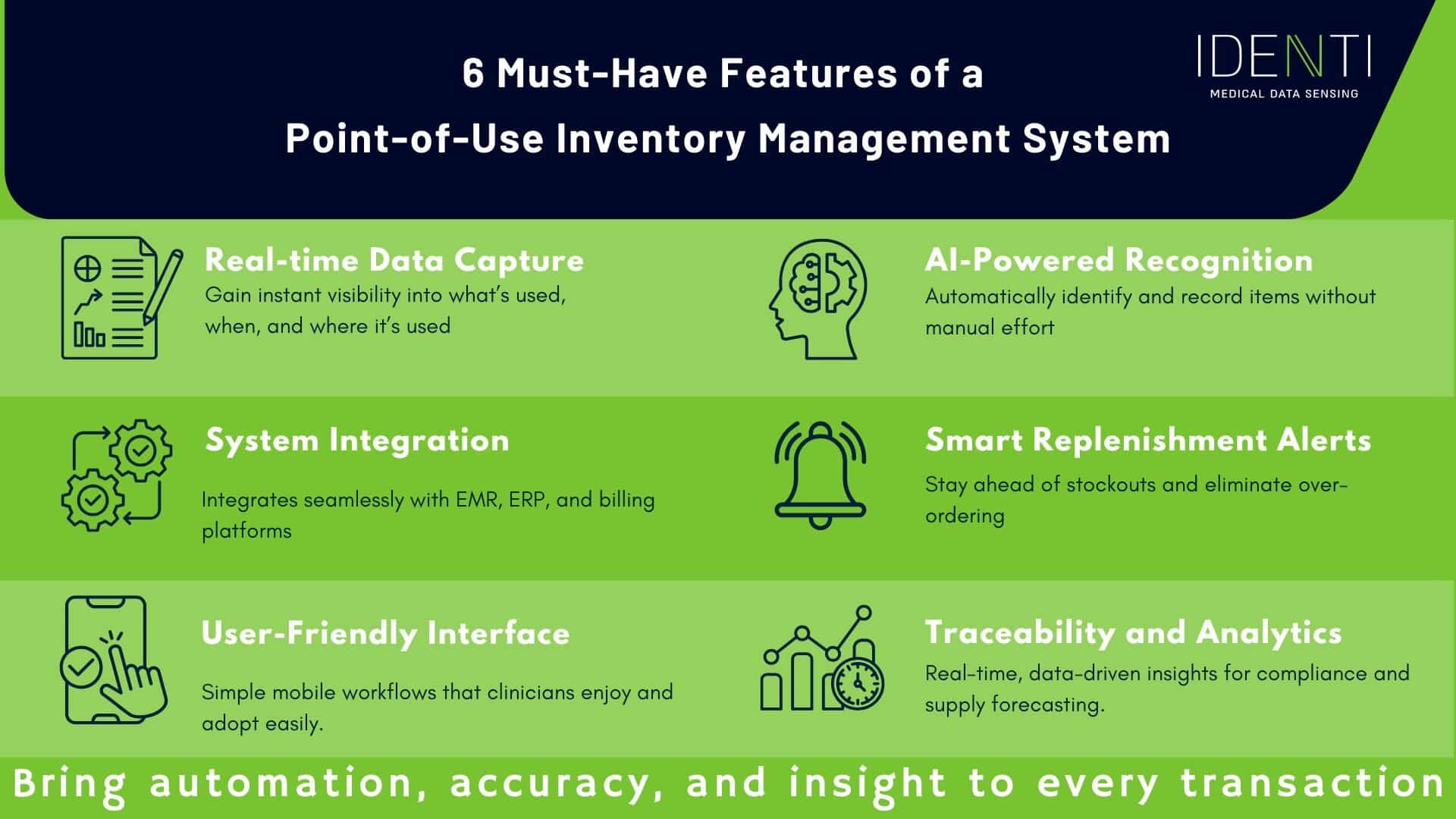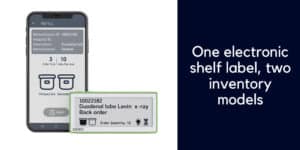What’s inside:
Efficient hospital operations depend on having the right supplies exactly when and where they’re needed. This guide explores how point-of-use inventory management systems are transforming hospital supply chains through automation, AI, and real-time visibility.
You’ll learn:
- Why point-of-use inventory management is critical for modern healthcare.
- The key benefits of automating supply capture.
- The six must-have features of effective POU systems (with infographic).
- How AI and analytics are shaping the future of hospital inventory management.
Learn how IDENTI’s point-of-use technology brings automation, accuracy, and control for every product used.
In every hospital, one fundamental truth holds: if the right supplies aren’t in the right place at the right time, patient care suffers.
Behind every smooth surgical procedure or emergency response is a complex network of hospital inventory management, which, while often invisible, is absolutely crucial.
That’s where point-of-use inventory management comes in. It’s the process of tracking, managing, and replenishing supplies directly at the point of care and ensuring clinicians have what they need, when they need it. When powered by advanced technologies such as RFID and computer vision, these systems not only save time and money but also elevate the standard of patient care.
For hospitals seeking to cut waste, capture every charge, and stay compliant, point-of-use inventory management systems have become indispensable. This guide explores their importance, the key features of effective systems, and strategies for successful implementation.
What Is Point-of-Use Inventory Management in Hospitals?
Point-of-use inventory management is the automated process of capturing, monitoring, and replenishing medical supplies —such as consumables, implants, and procedural supplies —where patient care occurs.
Unlike traditional manual systems, point-of-use technology connects clinical, operational, and financial teams through a unified data flow. Supplies are identified, documented, and replenished in real time, eliminating the need for manual counting or paperwork, and supporting smarter healthcare supply chain management.
Solutions like IDENTI’s Snap&Go use computer vision to automatically capture product usage in real time, while TotalSense RFID Cabinets provide secure, intelligent tracking of high-value inventory like implants and surgical supplies.
Why Hospitals Need Smarter Point-of-Use Inventory Management
Hospitals lose millions each year to expired, lost, or undocumented inventory. Much of this waste stems from fragmented or outdated medical supply tracking processes.
5 Key Benefits of Implementing Point-of-Use Inventory Management
A robust point-of-use inventory management system addresses these challenges by providing:
1. Accurate, Automated Documentation
Manual data entry during procedures often results in errors and missed charges. Smart point-of-use systems like Snap&Go, powered by AI and automation, capture product usage in real-time, minimizing manual input and ensuring every item is documented accurately.
2. Improved Visibility and Control
Real-time inventory tracking allows staff to monitor stock levels, expiration dates, and usage trends across departments. With real-time tracking, supply data is updated continuously as items are used or replenished, which helps materials managers optimize purchasing, prevent shortages, and reduce overstocking.
3. Greater Staff Efficiency
Hospitals using automated point-of-use systems reduce overstock, prevent expired inventory, and ensure full charge capture, which directly impacts the bottom line.
4. Reduced Costs and Waste
By eliminating over-ordering, minimizing expired items, and enhancing charge capture, hospitals can significantly decrease supply chain waste and increase revenue, achieving better supply chain efficiency.
5. Enhanced Compliance and Traceability
Regulatory requirements mandate accurate documentation of implantable and high-risk items. Point-of-use systems create a digital chain of custody from supplier to patient, supporting full traceability for implantables and high-value consumables. This aids hospitals in maintaining compliance with the FDA, the Joint Commission, and internal audit standards.
Must-Have Features of an Effective Point-of-Use Inventory System

Each of these features contributes to reducing waste, ensuring compliance, and enhancing staff efficiency. Combined, they transform inventory management from a manual process into a data-driven strategy for clinical and financial success.
How to Successfully Implement a Point-of-Use Strategy
Adopting a modern point-of-use system is more than just a tech upgrade; it represents a strategic transformation of hospital workflows towards smarter, more integrated hospital inventory automation.
- Assess Current Processes: Identify inefficiencies in documentation, communication, and stock management.
- Engage Stakeholders Early: Include clinicians, materials managers, IT, and finance teams in the planning process.
- Select the Right Technology Partner: Choose a scalable tech that integrates seamlessly with your existing hospital systems, such as EMR, ERP, and billing.
- Train and Support Staff: Provide continuous education to ensure staff confidence and compliance in daily use.
- Monitor and Optimize: Use analytics from your point-of-use system to track performance, identify savings, and continuously refine workflows.
What’s Next: The Future of Hospital Inventory Automation
As hospitals embrace AI-powered inventory solutions and IoT-based supply chain automation, point-of-use inventory management will become even more intelligent.
Tomorrow’s smart hospital will:
- Predict usage trends using machine learning.
- Automate replenishment based on actual consumption.
- Integrate seamlessly with financial and clinical systems.
- Deliver instant analytics for compliance and cost control.
By embracing this innovation, hospitals gain a strategic advantage, achieving better operational efficiency, improved staff satisfaction, and enhanced financial sustainability.
Smarter Inventory = Better Patient Care + Better Margins
Point-of-use inventory management isn’t just about supplies. It’s about creating a lean, resilient hospital ecosystem where patient care is never compromised by missing materials or missed charges. By adopting an automated, AI-driven point-of-use inventory management system, hospitals gain greater visibility, accuracy, and control across their medical inventory, ultimately delivering higher-quality care at lower cost.
Discover how IDENTI’s Snap&Go and TotalSense solutions are redefining point-of-use inventory management






